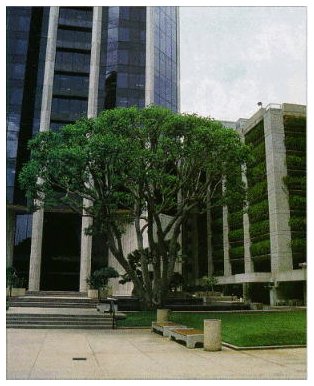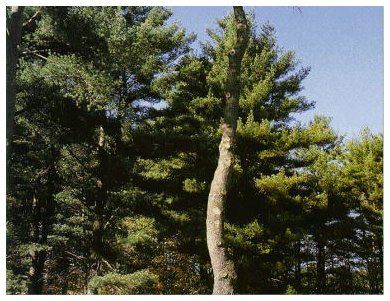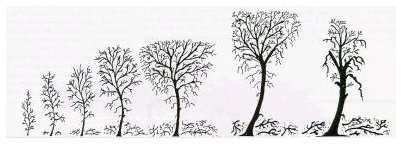 Two examples
of over-pruned trees, where too much symplast has been removed.
Two examples
of over-pruned trees, where too much symplast has been removed. By Dr. Alex L. Shigo
Tree pruning is a two-part treatment that demands a specialized knowledge
of collars and dose. Knowing. how to remove a branch without injuring the
tree requires an understanding of branch anatomy and defense boundaries,
whereas knowing how many leaf-bearing branches can be removed without injuring
the tree requires an understanding of the symplast and the second law of
energy flow.
I asked a physicist friend recently what natural law he thought was the most important to sustain life. Without hesitation, he said it had to be the Second Law of Thermodynamics or energy flow, which states that no system will remain orderly, or survive, unless it receives a continuous supply of energy.
Next, I asked a business friend what law he thought was most important in business. Just as quickly, he replied "cash flow." He stated that a successful entrepreneur needs to know how to get money, what to do with it, and when and how to let it go. He added that cash-flow problems are central to most business failures in big and small companies alike.
We expect doctors, mechanics and others who call themselves professionals
to understand the parts and processes of their business. We should demand
no less from arborists. Below are some very brief comments that will make
arborists more aware of a few neglected but essential parts and processes
for correct tree pruning.
I deal with these
subjects in a much greater detail in my books.
 Two examples
of over-pruned trees, where too much symplast has been removed.
Two examples
of over-pruned trees, where too much symplast has been removed.

Two major myths have held back advances in arboriculture: Wood is dead, and decay is not a disease. These myths arose mainly from the lack of understanding of the symplast.
The symplast is the highly ordered, three-dimensional, connected webwork of living protoplasm in trees. It's like a webwork of jelly. The living protoplasm is contained in thin-walled cells called the parenchyma, which have small cell wall openings that act as tunnels where the protoplasm of one cell connects with the protoplasm of adjoining cells.
It is extremely important to remember that the symplast is alive. Energy reserves are stored within the living symplast, mostly as starch and oils. Twigs, branches, trunks and roots all have a symplast, which stores energy reserves. The greater the volume of the symplast, the greater the capacity to store energy reserves.
The symplast is very fragile and requires a rigid framework, the apoplast, to hold it in place.
The apoplast, on the other hand, is a dead framework. It is a highly ordered connection of dead cells and cell parts that act as a tough framework for the symplast. The apoplast stores water, mostly as bound water, which, unlike free water, is chemically bound to cellulose and does not flow. A unique feature of trees is that living and dead cells are connected in ways that support the heavy, woody framework while maintaining the biological process essential for life. Wood is a highly ordered arrangement of living, dying and dead cells that have walls of cellulose, hemicelluloses, and lignin.
So, how does this all affect tree pruning? Removing living branches, stems or roots from trees reduces the volume of symplast. Since energy reserves are stored in the symplast, the energy reserves of the trees are reduced.
For the living processes of the tree, there is a great difference between
killing and dying-even though the end result is the same. As a branch dies,
mobile materials such as nitrogenous substances have a chance to move back
into the still living tissues. When a living branch is suddenly removed,
all of the nitrogenous substances are lost.
 As trees
mature, the ratio of dynamic mass, or symplast, declines from 100 percent
to 10-20 percent.
As trees
mature, the ratio of dynamic mass, or symplast, declines from 100 percent
to 10-20 percent.
Young trees contain living cells throughout, and the wood is said to be 100 percent dynamic mass. In fact, the definition of a young tree is one that is 100 percent dynamic mass. Significant amounts of the symplast may be removed from a young tree without seriously disrupting the workings of the Second Law, since enough energy remains to keep the parts and processes of the tree system orderly.
As trees grow and mature, however, the inner and oldest living cells begin to die, and nitrogenous substances move outward toward the cambial zone into the still-living cells. When cells die near the inner margins of the symplast, the dead material is called the protection wood. Heartwood is one type of protection wood. Sapwood is wood that has a symplast.
Protection is a static feature, whereas defense is a dynamic process. The symplast in the sapwood maintains a defense potential, because it contains living cells. Protection wood has very little or no nitrogen or energy reserves. Materials called extractives might also impregnate the dead cells.
As the volume of protection wood increases, the ratio of dynamic mass (symplast in sapwood) to static mass (protection wood with all dead cells) changes. Because the ratios are changing, the amount of symplast lost by removing living branches is also changing.
As trees grow and age, the demands of the Second Law become more pronounced. When wounds are inflicted and compartmentalized, the volume of dynamic mass decreases. If over-pruning, flush cuts, topping cuts or repeated deep injections are inflicted, the wood associated with the injuries is also compartmentalized. But again, as dynamic mass is walled off, the capacity to store energy reserves is decreased.
When not enough energy is left for a tree to maintain a strong defense, then pathogens attack. Usually, the roots are first to go, because they depend on leaves and living branches for their energy.
By this time, you may be asking where all this information may be found. Many researchers over a long period have contributed to what Dr. R.C. Hardwick calls the core-skin hypothesis, which states that as new growth increments or "new trees" grow over old increments or "old trees," the "young trees" become "skin" over the aging "core." As trees age, the ratio of "core" to "skin" increases.
Hardwick is must reading for anyone really interested in trees. I have
used many of his ideas in my book "Modern Arboriculture," because
they are very relevant to many tree treatments, especially fertilization
and pruning.
Generally, as trees get larger and older, the number of living branches you remove should decrease, while the number of dead branches that you should remove will increase. Of course, a branch should be removed any time it becomes a high risk for failure. And remember, always keep wildlife in mind when pruning.
I do not believe it is possible to give magic percentages for dose, or the number of living branches that may be pruned. Also, because of the forms of many trees, it is not possible to state how much should be removed and from where on the trunk. For example, American elms that are vase-shaped are still found in many cities, particularly in Canada. How you prune such a tree would be very different from how you would prune a round mulberry tree in the southwestern United States.
Each tree species has different mature forms and different ratios of dynamic to static mass. The collars on every branch will be different. Once these features are recognized and understood, only then can sound decisions be made about tree pruning.
Cash flow describes the movement of money within a business. Energy flow means the same for a tree's business of survival. Think of the component parts of a tree and its processes as similar to the workings of your business. You and your people are the symplast. If you are the owner, then you are the cambial zone. Your office and other non-living parts make up the apoplast.
When a tree business is small and young, it is mostly "symplast." As your business grows and ages, you must take care to recognize "dead wood" among employees and non-living things. The faster you discard "dead wood," the healthier your business will be.
A common saying in the corporate world is that the amount of money you make is less important than how much you keep. Indeed, as your business grows, you might find yourself making less money. This is just one argument against uncontrolled growth. Growing bigger and faster, then, does not always make for a healthier company or a healthier tree. In business, constant and careful pruning will maximize profits from limited resources. The same may be said for trees.
“An author, lecturer and consultant, Dr. Shigo started Shigo and Trees, Associates twenty years ago after retirement from the U.S. Forest Service.”
Reproduced with permission of Tree Care Industry and Dr. Alex L. Shigo.
The article was published in Volume 7, Number 3-March 1996 of TCI.
This site is dedicated to the remembrance of Robert Felix who for many years worked very hard for the improvement of the tree care industry: 1934-1996.
Back to articles or Back to pruning (Keslick And Son) section.
Dictionary MAIN
PAGE
Text & Graphics Copyright © 2009
Keslick & Son Modern Arboriculture
Please report web site problems, comments and words of interest,
not found.
Contact